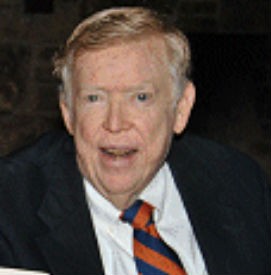
Ed Williams
The good (the life and times of the late Commissioner/County Historian Ed Williams), the bad (obstructionist Senator Ted Cruz), and the ugly (the governmental shutdown) are all subjects reviewed editorially this week.

Ed Williams
The good (the life and times of the late Commissioner/County Historian Ed Williams), the bad (obstructionist Senator Ted Cruz), and the ugly (the governmental shutdown) are all subjects reviewed editorially this week.
There is a famous quotation variously credited to Martin Mull, Laurie Anderson, Steve Martin, Frank Zappa, Elvis Costello, Miles Davis, George Carlin, and a slew of other creative wits but predating the lot of them: “Writing about music is like dancing about architecture.” The line is generally invoked to discredit music critics, but it’s really dancers who take the hardest hit. What’s wrong with dancing about architecture? Why not respond sonically, poetically, or physically to the landscape, man-made or natural? It’s a question a group of local dancers are asking as they prepare to perform “TREES: Dances and Odes for Tall Leafy Friends.”
“TREES” is a series of short environmental works inspired by specific trees in Greenbelt Park on the banks of the Mississippi River. Contributing artists including Robin Salant, Anne J. Froning, Bethany Bak, Marianne Bell, Wayne M. Smith, and Sarah Ledbetter, will use installation, improvisation, tap dance, storytelling, and a variety of mixed media to consider the life, shape, motion, and sounds of trees.
Ledbetter, the director, has described “TREES” as “an irreverent love letter,” although it was difficult to find much irreverence in a recent “open studio” work-through of the piece. Even the most humorous work, which finds a group of tap-dancing beatniks reciting sincere poetry, is infused with good old-fashioned capital-R Romanticism.
TREES: Dances and Odes for Tall Leafy Friends at Greenbelt Park on Mud Island, Saturday-Sunday, October 5th-6th, 5:30 p.m. Attendees should park at the lot approximately one mile north of the Auction Street bridge, where they will receive a program and beverages.
A show by Israeli artists Goldie and Moshe Monzon, a conversation with former prosecutor (turned murder-mystery novelist) Marcia Clark, “A Night Out With [humorist] Dan Zevin,” a holiday gift shop featuring jewelry, scarves, pottery, and more, plus a panel discussion on “fictionalizing” the Holocaust with native Memphians (and authors) Daniel Friedman and Anna Olswanger participating: They all add up to a first — the first annual Jewish Literary and Cultural Arts Festival at the Memphis Jewish Community Center, which runs throughout October and November.
The subject of the festival’s kickoff event on Thursday, October 3rd, is, appropriately enough, footwear. That’s when the MJCC will host a chat — and kosher luncheon — with Rachelle Bergstein, author of Women From the Ankle Down: The Story of Shoes and How They Define Us, and Jane Weitzman, whose book, Art & Sole, features fantasy shoes from the Stuart Weitzman collection.
Whose idea was it to launch such a festival?
The “vision” came from the MJCC’s new executive director, Larry Skolnick, and according to Amy Israel, the center’s arts and Judaic enrichment director, the idea was “to build a cultural arts department that enhances the MJCC experience for all Memphis community members. By highlighting Jewish authors and the Jewish arts experience we’re offering our members and the greater Memphis community an opportunity to learn, grow, and celebrate our culture.”
One of the key words above: “all.” Israel wants all Memphians to know they’re invited, and you don’t have to be an MJCC member to attend any of the festival events. But she’s recommending you get your tickets now.
“We have had a great response,” she says. “Everyone is excited to see the new energy at the MJCC, and the festival is one piece of the whole picture. This is a great beginning to an ongoing annual event!”
Jewish Literary and Cultural Arts Festival at the Memphis Jewish Community Center (6560 Poplar), October 3rd-November 19th. For more information, event dates, ticket prices, and reservations, go to jccmemphis.org/culture.
It’s the stuff of childhood. A boy stands in the green grass, sun on his face, dust in his eyes, and awaits that pitch to come screaming down the line. He’ll grip the bat, aligning it with anticipation and hope to get the big knock that will give his team the lead. It’s the same scene the world over, though we’re not talking baseball. This is cricket, and these are the blokes of summer.
Cricket in Memphis means weekend days filled with intense play for the nearly 250 men of the eight Memphis teams, part of the Ark-Tenn Cricket League governed by the U.S.A. Cricket Association, which is, in turn, overseen by the International Cricket Council.
It’s a Saturday morning in Bartlett, and the early September sun is already scorching the neatly clipped grass. The players for the Bartlett Youth Cricket Club (BYCC) and the Memphis Cricket Club (MCC) are prepared for the heat with oversized, floppy hats providing shade and faces slathered in sunscreen. Nearby, tennis matches are in full swing as a farmers market is set up in the parking lot. A children’s football game gets under way, and the aroma of a family reunion cookout wafts through the air. Players lounge in the shade of a portable canopy with Gatorade, bottled water, and Marlboros to trade tips and strategies in their native languages, as unfamiliar to the casual observer as a baseball catcher’s hand signals.
Sal Samana is an officeholder of the BYCC, whose members, many hailing from Pakistan, as he does, wear the green of that country’s national team. Samana makes a point to mention the city of Bartlett, saying he “appreciates the opportunity for a place to play the game.” The city, when contacted by the league, was willing to set aside the field and create a pitch for the teams to play on. Another field was created by the city of Memphis behind the Hickory Hill Community Center on Ridgeway at Winchester.
Cricket is somewhat new to Memphis, but elsewhere around the globe, there is evidence of cricket being played as early as the 16th century, sometime after Ferdinand Magellan circumnavigated the earth but before the Gregorian calendar was adopted. Its popularity was later spread throughout the British Commonwealth of Nations into every outpost under royal rule. Today, it is played by millions in 106 countries, second in world popularity only to soccer.
 Justin Fox Burks
Justin Fox Burks
Cricket had its heyday in America in the early 1700s, when it was known as America’s pastime. Really. A match between the United States and Canada in the 1840s was attended by 10,000 fans and is regarded as the first international sporting event. It was around this time that America’s current national pastime — baseball — was invented, and its allure would soon surpass that of cricket.
Organized cricket came to Memphis in 2006. It’s a game still on the fringes in this country, yet there it is, every weekend between March and November, on the fringes of Freeman Park on Bartlett Boulevard just outside the Memphis city limits.
There are several incarnations of the game, the most commonly referred to being Test cricket, where a single match can take up to five days to play. In Memphis, you’ll find the much shorter game of Twenty20 played. And because it might make it easier for Americans raised on a steady diet of ESPN to understand, let’s get to the similarities between cricket and baseball: Twenty20 cricket is played in innings (only two); there are batters (two as well, on the field at the same time) and a pitcher (he’s called the “bowler”). There you have it. There are no mitts or time limits, the batsmen are dressed like catchers, and a ball stays in play for 360 degrees around the batsman.
Despite the worldwide popularity of cricket, devoted spectators in Freeman Park are scarce. Dog walkers, parents following children on bikes, and joggers stop to watch the action from time to time.
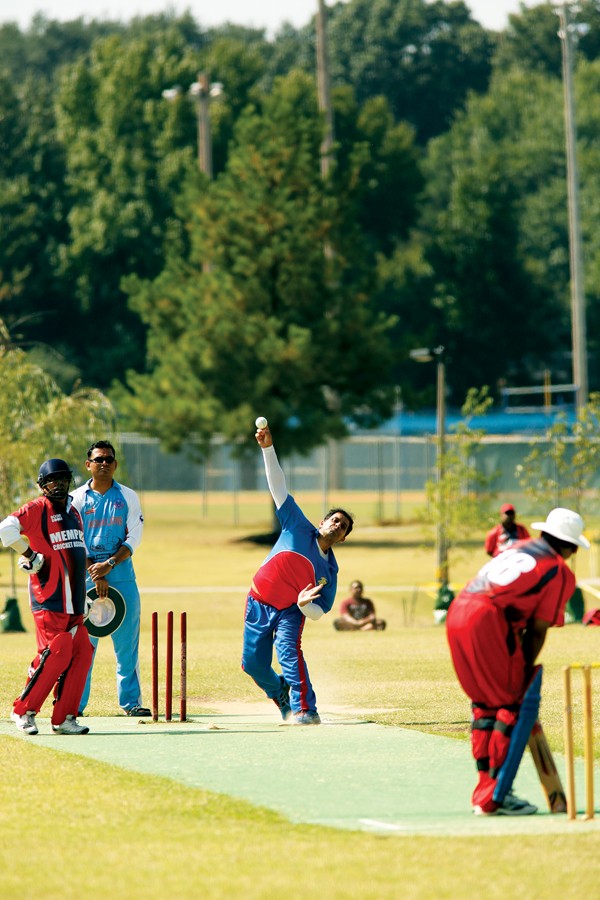 Justin Fox Burks
Justin Fox Burks
Amer Aziz of the BYCC is quick to ask a curious visitor if he has any questions and explains the rules. His attention, however, stays with his team, and he stomps away to stalk the sidelines like a coach and encourage his team on the field. “Keep the pressure on!” he shouts.
Ashish Vaidya, 33, is originally from Bombay, India, and grew up playing the sport, as many of his countrymen do. He moved here in 2005 and manages a nearby Comfort Inn. He points to the orange cones around the perimeter and explains that a cricket field is an oval with boundaries placed at 200 feet from the pitch, a 22-foot-long strip of concrete with outdoor carpet stretched along the top. At either end of the pitch are wickets — three upright “stumps” with pieces of wood known as “bails” balanced across the tops. The safety zone in front of the wickets is called the “popping crease,” and this is where the batsmen stand and inside of which they are safe while running.
Points are scored after a ball is hit and the two batsmen — the one batting is “on strike,” the other a “runner” — run to their opposite wickets. As they pass each other, one run is tallied. The batsmen may run back and forth as many times as possible before the ball makes it back to put down the wicket, resulting in an out. If a batted ball flies to within the 200-foot boundary and then rolls out, it’s four points; if it crosses over that boundary in the air, six are counted.
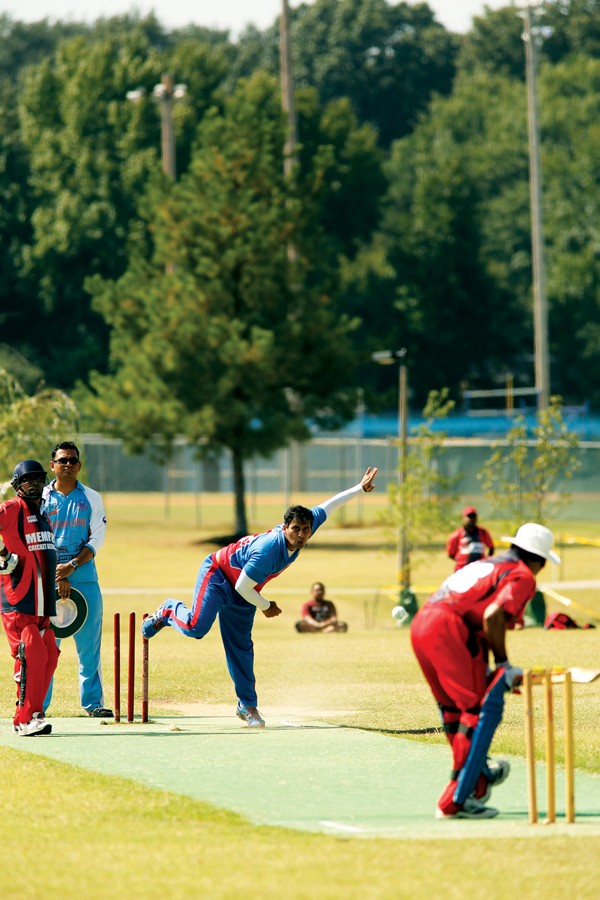 Justin Fox Burks
Justin Fox Burks
A batsman is out if the batted ball is caught on the fly or if the ball is pitched and hits the wicket without being batted and the bails are knocked from the top.
The duration of a Twenty20 inning is 10 outs or 20 overs, whichever comes first. An “over” is six legal balls pitched in succession. The pitch itself is a spectacle, the bowler uncoiling his body with a half-dozen leaping steps, his arms windmilling until the ball is released at the arc’s apex. The ball, heavier than a baseball, bounces on the pitch before screaming in at knee-height. The batsman hopes to alter its trajectory with a flat bat made of English willow.
It’s a slower game than baseball, if that’s possible. George Bernard Shaw said, “Baseball has the great advantage over cricket of being sooner ended.” But there is no denying the excitement when a big run is scored. The batting team is uproarious as their man makes contact and the ball sails out of bounds for a six. Aziz is on his feet, trilling the “d” and “r” together as he shouts, “Good run!”
Despite such bursts of action and enthusiasm, an hour into this Saturday match and there are only eight overs and two outs. The score is 67-0.
 Justin Fox Burks
Justin Fox Burks
Saravan Chaturvedi, originally from Hyderabad, India, is a programmer for MLGW and member of BYCC. His play predates the local organized clubs by nearly 10 years. When he first came to Memphis in 1997 for graduate school at the University of Memphis, there was no Ark-Tenn Cricket League. Instead, he and a ragtag group of fellow students — “usually hungover from late Friday nights,” he said — and a few professors would gather in a parking lot on Southern Avenue, alongside the tennis courts at the school, for a Saturday afternoon match. Dividing themselves into two teams made up largely of engineering students, Chaturvedi said, they would “take a tennis ball and tape it with duct tape so it would last longer and the bounce would be similar to that of a cricket ball.”
It was a way to stay connected to their culture and foster camaraderie among those far from home. And it was a little risky; the asphalt of the lot hindered any diving catches to make an out. In professional cricket, the ball might be bowled at more than 90 mph. Though it’s not quite that fast for these weekenders, they remain vigilant, as balls are caught barehanded by the 11 men in the field. With the ball in play anywhere, there is always the possibility for injury. Before the game on this September Saturday, a cricketer was taken to the emergency room for five stitches in the face after being hit by a ball deflected off his bat.
The Memphis players grew up playing their version of sandlot cricket and following their favorite professional teams. The majority are from India and Pakistan, though Vaidya said he’s played with folks from Australia, South Africa, and England. Ali Iftikhar of the BYCC grew up in Lahore, Pakistan, and is a devoted fan of the Pakistan national team. (The team is currently ranked 6th in Test match by the International Cricket Council.) Iftikhar came to the United States in 1992, eventually making his way to Memphis to manage Shoe Time stores. He gravitated to the recreational sport, he said, because “we don’t go out clubbing or to bars or stuff like that, so, for us, we needed something like this.”
Samana, a car salesman, was captain of his high school cricket team and played in college. He’s lived and played in Pennsylvania and Chicago, places with much more participation and more than 40 teams. He said cricket keeps the young men out of trouble: “I’ve had mothers tell me, ‘My kid was going to clubs. Now he worries he has to get up and play.'”
Iftikhar lived for a time in Miami and is a big fan of the Dolphins and Heat. He said the Michael Jordan or Kobe Bryant of Pakistani cricket is Imran Khan, a former cricketer and popular politician. “A lot of youngsters support him,” Iftikhar said. “He has a lot of seats in the [Pakistan Tehreek-e-Insaf] party, and other countries support him too.”
“There’s still that pull and identity that you feel,” said Chaturvedi, describing his devotion to the India national team (ranked third by the ICC). As a fan, he maintains that the best current batsman is India’s Sachin Tendulkar. It is universally accepted, though, that the best Test cricket batsman was Sir Donald Bradman of Australia, who played from 1928 to 1948.
Another Australian, Darren Beazley, is the new CEO of the U.S.A. Cricket Association (USACA). Though the popularity of the sport in America has waned since that match with Canada in the 19th century, Beazley is intent on revitalizing it. There are now 32,000 cricket players in 54 leagues around the U.S.
“It’s a niche sport,” Beazley said by phone from Indianapolis, where he was working with that city on hosting the national championships in August 2014. “Some leagues are very well organized, and they run quite big leagues. Ark-Tenn is an example of that. Others need a bit more help. We really feel that, by opening it up and making it broader and getting more boys and girls from all walks of life involved, we can actually start to get more people aware of cricket and understanding that cricket’s not a five-day game. The form that we’re promoting is Twenty20, which is three hours, the same length as a baseball game.”
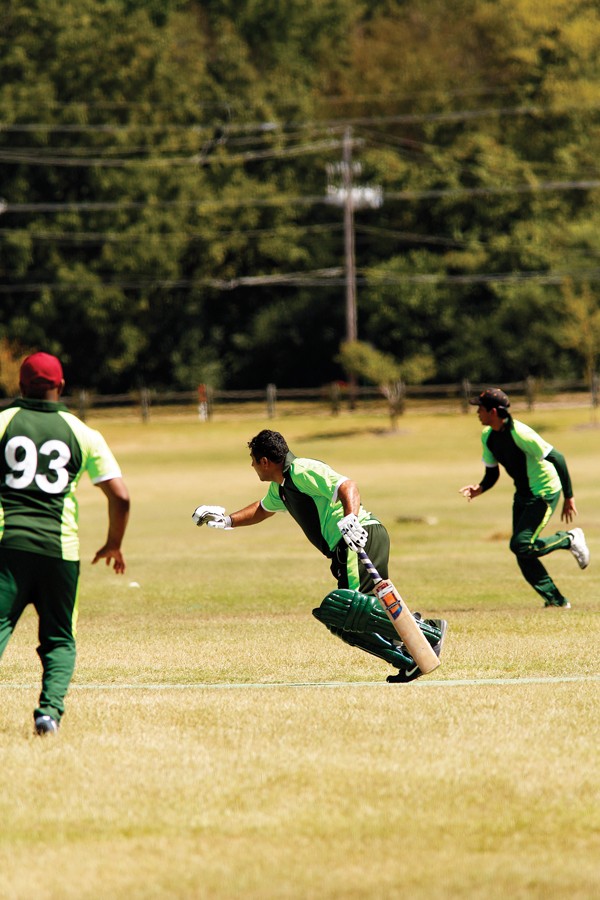 Justin Fox Burks
Justin Fox Burks
Beazley has traveled the country since arriving eight months ago in an effort to broaden his sport’s appeal. He visited Memphis two months ago and was impressed with the city and the cricket community. As coincidence would have it, Memphis is also the home of Beazley’s mother-in-law.
The Cricket World Cup is held every four years, most recently in 2011 in Mumbai and won by India. A pivotal moment in world cricket was 1983, when India upset the long-reigning team from the West Indies.
“The game of cricket changed in 1983, with India winning, and so the center of the political power of cricket gradually moved from England to India,” said Chaturvedi, adding that its governing organization, the Board of Control for Cricket in India, has become the most powerful board in the world. “India went crazy for cricket after 1983.”
Beazley and the USACA have impressive goals for cricket in this country, with a three-year plan aimed at increasing the number of players to 50,000, engaging media outlets such as ESPN to air championship series, and increasing and improving regional facilities.
If the enthusiasm on the pitches in Bartlett and Hickory Hill is any indication, the fever for the sport runs high. With the community of immigrants expanding as more and more international companies look to Memphis, the fervor to play should increase. A sport on the fringe may even begin to hold its own in the land of SEC football and Grit ‘n Grind.
Two hours into the September Saturday match, the farmers market has called it a day, and the football game has ended. With one inning in the books, the MCC ends its time at bat and the BYCC comes on strong. Though they are determined, they’re unable to pull out a win, losing 148-112.
As with any sport, there is a winner and there is a loser, but for these men, there is also sportsmanship, a welcome cultural familiarity, and an attachment to a sporting tradition as old as the calendar and as traveled as Magellan.
It’s fall, y’all. Are you ready for some cricket?
The results of this year’s Flyer Box Art contest exceeded all expectations. Thirteen artists transformed 11 of the Flyer‘s ordinary newsstand boxes into gallery-worthy art that will soon make Memphis an even more colorful place.
Now in its second year, the Flyer Box Art contest drew another father-daughter team, students, and working artists. They turned in boxes that ranged from flat-out adorable and super-trippy to outrageously slick and sweetly thoughtful.
Again this year, you can vote for your favorite box in the “Readers’ Choice” contest online at memphisflyer.com, starting this Thursday, October 3rd, and running through October 31st. The winner will receive $500.
Thank you to the Art Center for its continued support of this contest.
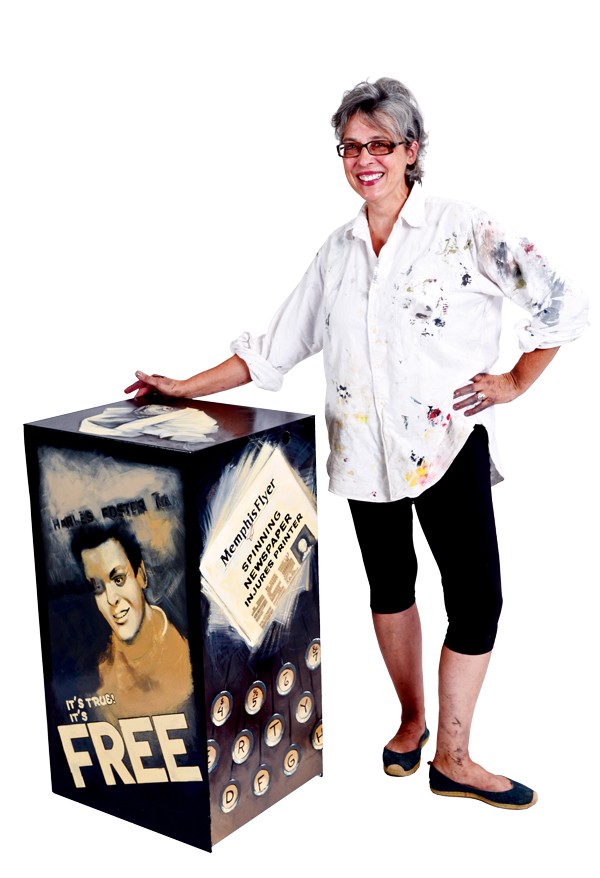 Larry Kuzniewski
Larry Kuzniewski
Mary Norman
Mary Norman has been a member of the local art community for many years but took a 12-year hiatus to raise her son. Her reentry into the scene was huge. It was Norman who created the steam-punk-style mural with the sprockets and ominous giant eye on the security offices in Overton Square.
Norman’s Flyer box, though on a smaller scale, is every bit as dramatic as the Overton Square mural. The theme is “Stop the Presses,” and it’s an homage to the newspaper biz as represented in old black-and-white movies. Orson Welles of Citizen Kane flanks one side of this shades-of-gray box; the sharp-as-a-tack Rosalind Russell of His Girl Friday appears on another side.
Other flourishes include a sprinkling of typewriter keys and the spinning world of old newsreels. At top is an amazing 3D fish, which Norman notes is her way of saying that the idea of print newspapers being obsolete is exaggerated. You can’t, after all, wrap a fish in a computer.
Location: Auction Street Bridge at A.W. Willis
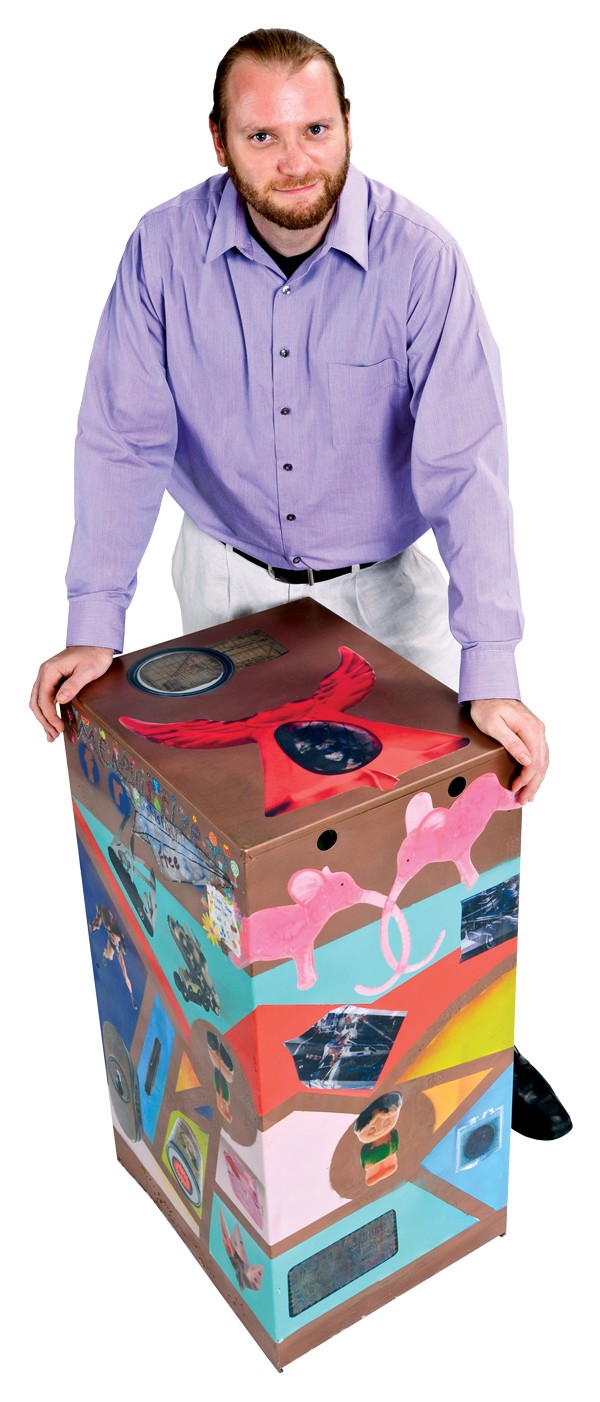 Larry Kuzniewski
Larry Kuzniewski
Jason Miller
Muralist Jason Miller’s art box can best be described as psychedelic folk art, with pink elephants, army tanks, and action figures adorning the box.
Miller’s box also features a lot of memorabilia specific to the artist: an Elvis autograph owned by his mother, a teething toy, ornaments from his grandmother, and old paper planes the artist made as a child. Using archival spray paint as a base before sectioning off different areas of color, Miller’s art box looks complex without being cluttered and serves as a great introduction to this accomplished artist’s work.
Location: 5425 Poplar, in front of Outdoors Inc.
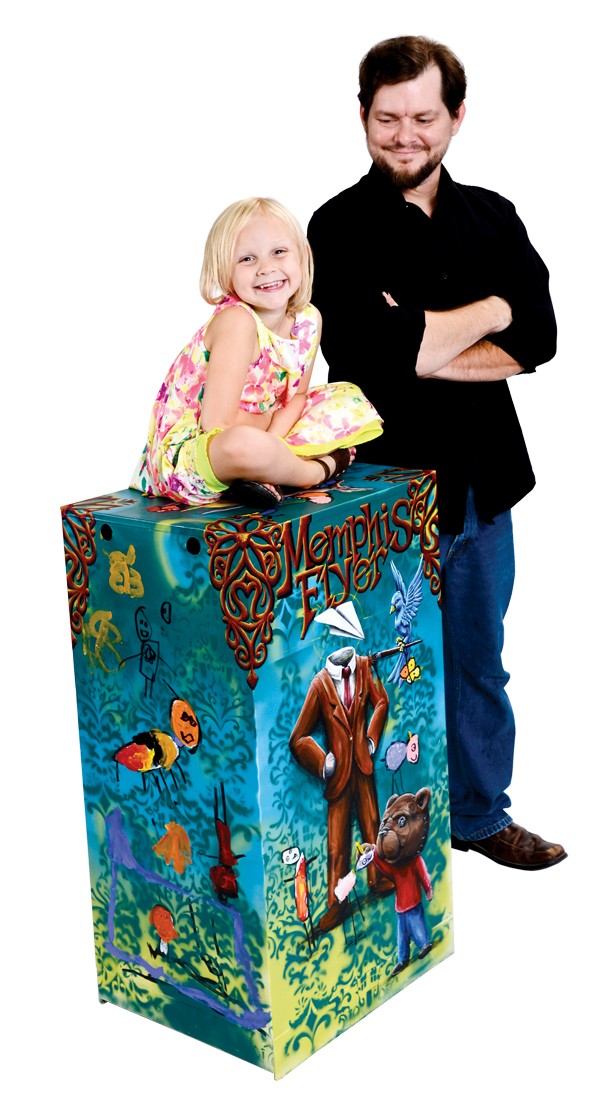 Larry Kuzniewski
Larry Kuzniewski
Mollie and Nathan Parten
“I draw lots of good things,” Mollie Parten tells us. Among those good things are unicorns and butterflies and herself. Mollie is 5. Her partner-in-art is her dad Nathan, a tattoo artist at Trilogy and the creator of the Day of the Dead-inspired Little Dead Things prints and candles sold at the Brooks.
The Partens, who previously collaborated for a show at Tsunami, delivered a colorful box with lots of playful, storybook-like details. That huggable little button-eyed tiger stands for the Memphis Tigers, and that just-as-cute bear is for the Grizzlies. The blue house swarmed by musical notes represents Memphis as home of the blues. “Memphis is a big old playground — sports, music … unicorns,” Nathan says, summing up the box.
Mollie’s contributions to the box include, yes, a unicorn, a butterfly, and herself. She’s also immortalized on top of the box. In this portrait, she has rabbit ears and, naturally, a unicorn’s horn.
Location: 3775 Central, in front of University of Memphis Scheidt School of Music
 Larry Kuzniewski
Larry Kuzniewski
ERF: Lauren Rae Holtermann and Ronnie Lewis
The iconic smiling pig that once gazed out over Madison and other Piggly Wiggly locations in Memphis may be a thing of the past. But Mr. Pig lives on, thanks to the Flyer art box by the ERF design collective.
The pop-art-style box features a stencil of Mr. Pig spray-painted in bright colors. Created by Lauren Rae Holtermann (full disclosure: Holtermann works in the Flyer‘s art department) and Ronnie Lewis, the box is a salute to the fact that Memphis was home to the first self-service grocery.
“My dad said, ‘Why would you do that? There are no more Piggy Wigglys,’ and I said, ‘Exactly!'” I miss seeing that pig everywhere,” Holtermann says.
Holtermann and Lewis collaborate with a couple of other artists in ERF to create album art and posters for metal shows at the Hi-Tone and Minglewood Hall. Holtermann painted a Flyer box last year as well.
Location: Union at Cooper
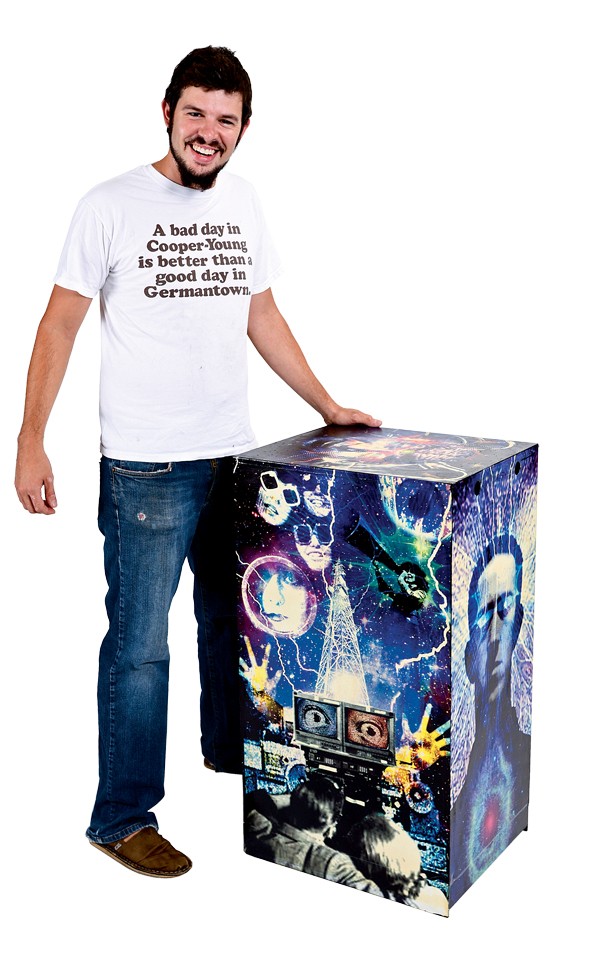 Larry Kuzniewski
Larry Kuzniewski
Gino Barzizza
Gino Barzizza’s wife signed him up for a Flyer box without telling him. But the graphic designer wasn’t fazed. He even scrawled a love message for his wife on the inside of the box. Barzizza printed a sci-fi scene onto vinyl using an ink jet printer. “It’s about shared visions and how, with the internet and computers nowadays, something that was once metaphysical and magical is now technological,” Barzizza says. “You can witness all the stuff that everybody else in the world is witnessing, and the only thing you have in front of you is a computer.”
Location: 412 N. Cleveland, near the Hi-Tone
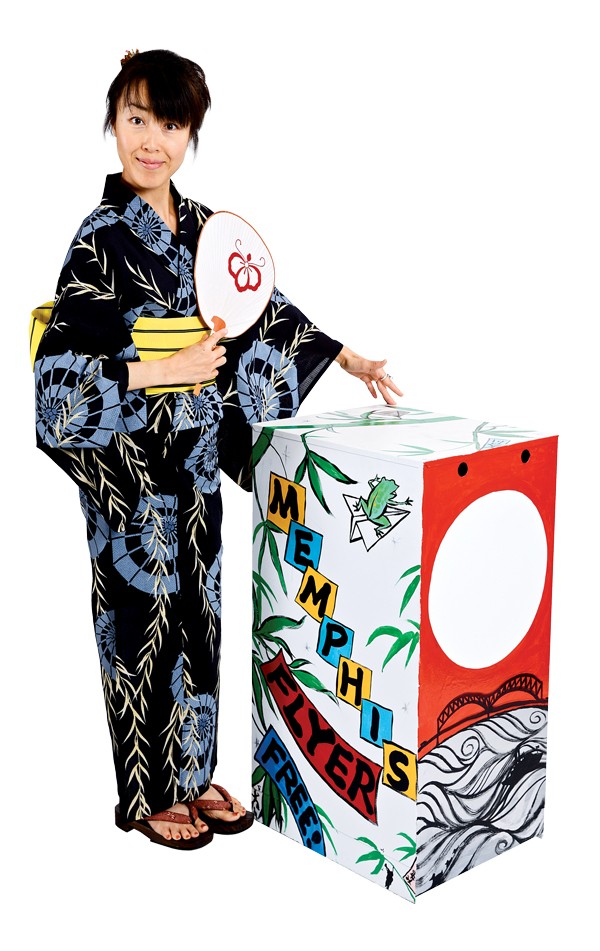 Larry Kuzniewski
Larry Kuzniewski
Masumi Oizumi
In Japan, during the Tanabata festival, people write wishes on slips of paper and hang them on bamboo, along with other decorations. Then the bamboo is set afloat on a river or burned after the festival.
Masumi Oizumi painted a bamboo stalk decorated with iconic Memphis and Southern imagery, such as the Pyramid, catfish, W.C. Handy, and a pig. “Memphis Flyer” is spelled out on the wish slips.
Oizumi was a textile designer when she lived in Japan, but since moving to the United States, she hasn’t been doing much in the way of art. She says the design contest was her way to reacquaint herself with her old hobby. When she’s not painting, Oizumi and her husband bake bread to sell at the Local Lynx Farmer’s Market at Rhodes College.
Location: 1761 Union, near Kroger
 Larry Kuzniewski
Larry Kuzniewski
April Pierce
Grad student April Pierce says she wanted to keep things simple and playful with her art box. Pierce took snapshots of people she knew reading the Flyer as a starting point, before painting characters inspired by her photos on the box and filling up the space around them. Pierce admitted that using enamel paint for the first time was a challenge, but the chance to have her art seen by people around town made it worth it.
“I see the boxes from last year around town all the time, and I think it’s just a really fun way to liven up the landscape, so I’m really happy to be a part of it,” Pierce says.
Location: 3739 Walker
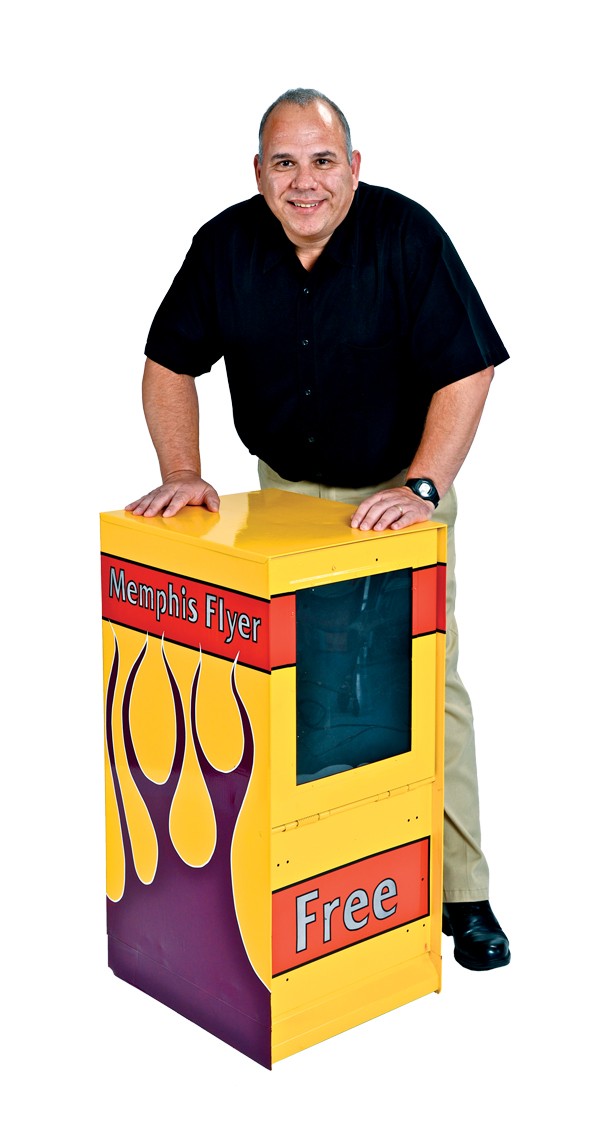 Larry Kuzniewski
Larry Kuzniewski
Robert St. Clair
The Flyer box created by graphic designer Robert St. Clair looks like it might zoom off the pavement, thanks to a paint job suitable for a souped-up Camaro. St. Clair says he decided on the automotive aesthetic, because it would quickly draw attention in a high-traffic area.
St. Clair approached painting the box the way you would a sports car, using four coats of clear paint, lettering enamel, and stripping tape. The result is the fastest-looking Flyer box to date.
Location: Poplar and Perkins Ext., Sears bus stop
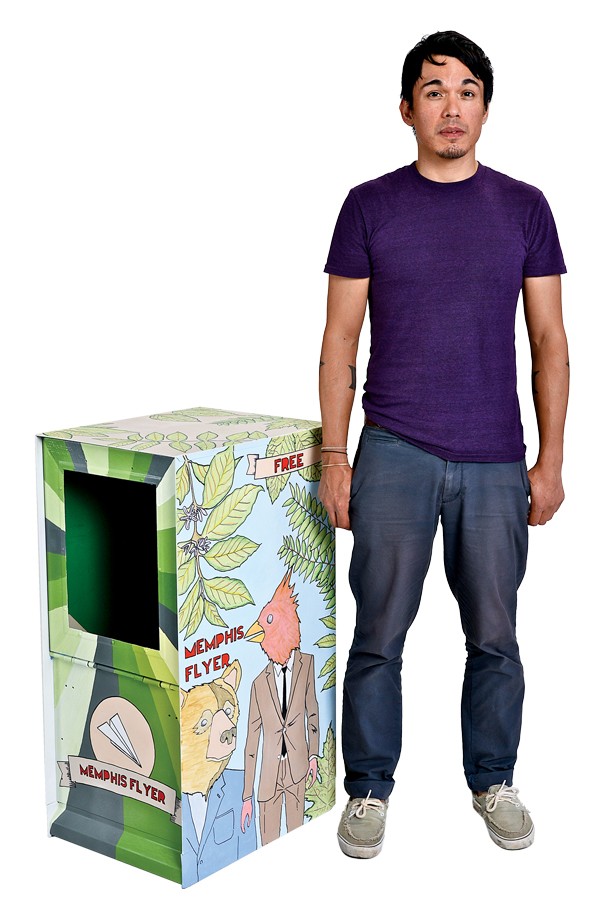 Larry Kuzniewski
Larry Kuzniewski
Pete Hoffecker
Pete Hoffecker’s Flyer box features illustrations of the three major sports mascots in Memphis, all dressed in suit and tie. A redbird, two tigers, and a grizzly adorn the box, looking similar to characters from a Richard Scarry children’s book.
Says Hoffecker of his box: “I wanted something that represented Memphis without going overboard and putting Elvis on there, so I decided on a really slight head nod to the sports teams here. The other filler is to make it look more organic and natural. I’m interested in indigenous art, and I wanted to make sure that was represented with my box.”
Location: Madison and Pauline, Medical District
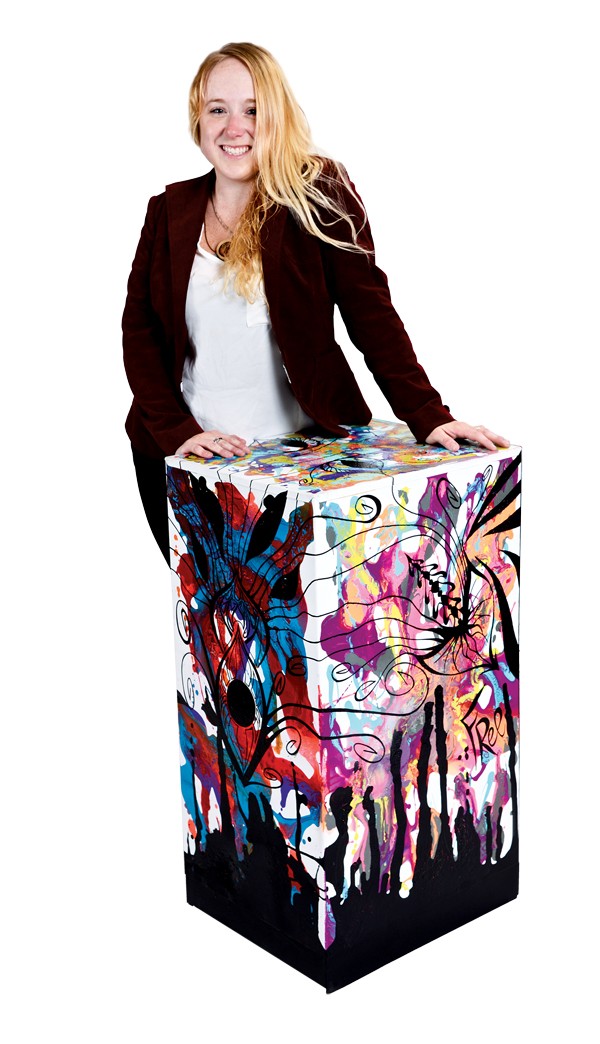 Larry Kuzniewski
Larry Kuzniewski
Lindsey Penn
Lindsey Penn studied dance, but this self-taught artist says, “I’ve always had a knack for making stuff.”
Penn recently attended Burning Man and drew inspiration from the annual festival geared toward “radical self-expression.”
Her box is an abstract work with brilliant splotches of color — yellows, greens, pinks, and oranges — all battling for the eye. Order comes in the beautiful, free-hand, calligraphic black lines that float to the surface. Recognizable shapes appear. One pattern could be a lion’s face. Or is it a squid?
Penn says her thought-process was that there was no thought-process. “I don’t start with a plan. I just do,” she says. “It becomes whatever.”
When pressed to describe her entry, she says, “My box is chaos.”
Location: 665 S. Highland, in front of Oasis Hookah Lounge
 Larry Kuzniewski
Larry Kuzniewski
Paige Ellens
“I wanted to do something to put myself out there,” Paige Ellens says, explaining why she entered the contest. “Out there” is also an apt way to describe her Flyer box, though the adjectives she uses are “funky,” “crazy,” “eccentric,” and “bizarre.”
The theme for Ellens’ box is “Memphis Is a Circus.” She began by painting wide vertical lines. Then she created fabulous morphing tableaus. On one side is a giant pair of lips, teeth that evolve into curtains, and a green tongue that serves as a lawn. On the other side is a green face with eyes that can also be read as circus tents. For the lettering, she borrowed from old circus flyers.
Says Ellens, “I was going for something crazy, quirky.”
Location: 1902 Nelson, in front of Archer Recordsvv
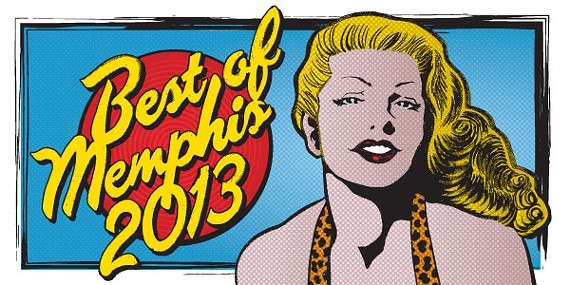
Best of Memphis
Some spam thing has been posting all week on my Twitter: “Sorry, Commercial Appeal, but the Memphis Flyer is the real Memphis Most.”
That’s some accurate spam. Just sayin’. Congrats on a great Best of Memphis edition (September 26th issue).
Dave Litchfield
Memphis
Fathers
My heart goes out to Joe Buchanan, the subject of Louis Goggans’ article “Father Knows Best?” (September 26tth issue). But I am afraid Buchanan will face great difficulty trying to get any support from the public and media for his new organization addressing the rights of non-custodial parents.
Women have rights; men just have responsibilities. If a woman isn’t ready to be a mommy, she just has an abortion. But if a man isn’t ready to be a daddy, well that’s just too bad. You’ve got to “man up” and take responsibility for your actions for the next 18 to 21 years or society will put you in jail.
Shortly after Roe v. Wade, Karen DeCrow, president of the National Organization for Women, said, “If a woman makes a unilateral decision to bring a pregnancy to term, and the biological father does not, and cannot, share in this decision, he should not be liable for 21 years of support … autonomous women making independent decisions about their lives should not expect men to finance their choice.” That sensible attitude is sadly shared by a limited number feminists.
In California, an appellate court upheld an order forcing a 15-year-old boy to pay child support to his 34-year-old statutory rapist after she became pregnant and gave birth. Texas, Ohio, and Kansas also have laws requiring male victims of statutory rape to pay child support if their rapists become pregnant.
I can’t conclude this tirade without a mention of paternity fraud. A California judge ruled that combat veteran Sergeant Brandon Parsons must continue to pay child support for a child that his girlfriend conceived during one of her sexual affairs while he was in Iraq. In many states, if a woman can make a man believe the child is his for two years, he is forced to continue to pay child support regardless of the outcome of future DNA paternity testing.
This case is not atypical of paternity fraud. Good luck, Mr. Buchanan, and kudos to the Memphis Flyer for reporting your struggle.
Dan Hankins
Hernando, MS
Small Business Troubles
We’re small business owners who relocated to Memphis three months ago. We love it here, and are grateful to have been so warmly welcomed. The only thing missing for us in our newly adopted town is the “official” information flow.
Case in point: We rolled out our new smoothie truck, Memphis Punch, last week at the U of M football game. We rented space from one of those big grass parking lots; set-up, fed people, took in the scene, cheered on the Tigers from a distance. Then, 20 minutes after kickoff, up rolled three members of Construction Enforcement of Shelby County. We needed to have a special-event license to be working at the game. Here’s a ticket, here’s a court date.
We didn’t know. No problem. We wanted to get ahead of it next time, and who better to answer our questions than county employees themselves? When exactly do we need one of these licenses? we asked them. What constitutes a “special event”? How much is this fine, anyway?
No answers. It’s “not their job” to tell us. We called the following Monday to ask the same questions during business hours. We tried the county web site. No answers.
We’ll pay the ticket. We’ll make the court appearance. But we can’t help feeling like we just got a speeding ticket on a road with no speed limit signs. Isn’t it better for us and for Memphis if small business owners have access to the right information before we get fined, instead of after?
Billy Bicket, Laney Strange
Memphis
Something Stupid
You published a letter to the editor in the September 26th issue that stated that 15 percent of the U.S. population is homeless, and that 25 percent of those homeless people are veterans. So, we have 48 million homeless people in the United States? And 12 million of them are veterans?
Does anybody read those letters before you publish them? I was on the newspaper staff when I was in high school. We didn’t have Google then, but our advisor insisted that we give everything we printed at least a cursory glance so that we didn’t look like fools when we published something stupid.
Hope Brooks
Memphis
“I love the Flyer! What do you do there?”
Going on 23 years, I still get that at least once a year. Life’s way of keeping you grounded. The answer is soon to be “not much,” but first a little background.
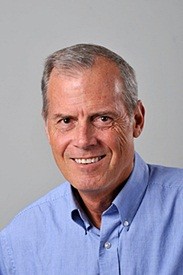
John Branston
It was 1990, and the speaker at the Peabody was talking about the promising prospects of free “alternative” weekly newspapers. Bob Roth, founder of the Chicago Reader, was wearing boots and jeans and had a beard and a ponytail. So far so good. He said something about the typical alt-weekly reader buying several CDs every month. Lotta money, I nodded.
Of course, he was talking about compact discs, not certificates of deposit. For someone whose music collection was still vinyl, it was an early sign of a challenging marriage. I had recently turned 40, and publisher Ken Neill was looking for someone who could write it long or write it short and keep the newborn Memphis Flyer edgy but out of trouble while its grown-up sibling, Memphis magazine, paid the rent. I bit. First suggestion: It is not a good idea to have a local feature called “Rumor Mill.”
A free paper, competing with one of the most profitable dailies in the country. Fat chance. Over the next 15 years, 16-page papers would become 28 pages then 44 pages then 96 pages a few glorious weeks. Party!
Dick Hackett was mayor, Harold Ford Sr. was between trials, and Willie Herenton was an unemployed former superintendent. “Free” was still the exception and not the rule in news, and strip-club ads supported this and other weekly papers. Facebook, Twitter, blogs, pay walls, and trolls did not exist. Our most faithful correspondent wrote upbeat weekly letters to us in longhand. Penmanship and notepads had not disappeared, the internet was a few years away, and a Rolodex and a reverse city directory were handy things to have. And the women who are now our advertising director and operations director were babysitting my children.
What, exactly, did alternative mean? The punk rocker who took a dump on stage at the Antenna club and the bond trader at First Tennessee who called a colleague a “f—ing goombah” and got sued over it were about to test our definition. Absent smartphones, the Flyer had the scoop.
“Tell me something interesting I didn’t know,” suggested Henry Turley. His sequel, equally wise, was, no matter who you are, “sooner or later, people get tired of your bullshit.”
Soon enough, big news came along, like the Herenton cliff-hanger election, the casinos, and the Ford trial and acquittal, that let us show our stuff. The beauty of working for a company with multiple “platforms” — as we now say at Contemporary Media Inc. (MBQ magazine and memphisflyer.com joined the print paper and Memphis) — is the ability to change gears from a 10-part series to a 4,000-word story to anniversary issues to books to columns and blogs, which we once called “Bobs.”
At some point, I decided I had earned pundit’s rights. A cartoon I saved for years showed a columnist blindly tossing a dart at a board that read, “Today I am an expert in,” with slots for nuclear physics, medicine, stocks, sports, government, and international affairs. I replaced it a few years ago with a “Doonesbury” strip wherein aging reporter Rick Redfern is asked by his son what he does if he has nothing to say, and he tells him, “Say it anyway, four times a day. I don’t have a pension.”
There’s a lot of truth to that. “Reacher said nothing” is a good narrative device in Lee Child’s tough-guy fiction, as well as excellent advice in real life, unless your job includes feeding the Web beast. Good writers are usually great reporters and interviewers — Jackson Baker, for instance. Whether selling or writing, this is an in-your-face business. I hope it lasts.
Doing work you would (sometimes) do for free and making enough to raise a family is not a thing to be taken for granted, especially when allowed to do it without fear or favor or interference. I sincerely thank my present and past colleagues, our board, advertisers, and especially our readers. The term “alternative weekly” needs to be redefined, and fresh horses are key to any going concern. The next hire should have a thousand friends and followers and zero CDs.
I have a half-finished book and some other things I want to do. I’m younger than half the dudes in the geezer bands playing Tunica. Ken Neill, a friend indeed, has offered to call me a contributing writer until I turn 65 next year and make a killing in Social Security, Medicare, and day trading.
What? No killing? But I’m an expert!
You can’t sling a cat in Memphis without hitting a bass player. But banjo players? That’s another matter. World-champion banjo players? There’s only one: Randal Morton.
“My twin brother, Greg, and I started out in 1969,” Morton says. “They called us the Morton Twins. One night, I watched the Glen Campbell Good Time Hour show back in 1969. John Harpeth was playing banjo, and I decided that’s what I wanted to do.
“In 1975, I ended up winning the National Banjo Championship. We worked with Mark O’Connor. On the festival circuit, we became friends with Vince Gill, Marty Stuart, Bill Monroe. Later, we went on USO tours to the Orient and Europe.”
How does is get any better than that?
“Then we ended up going to Hawaii for three years, and we worked on the Don Ho show. We were probably 19 or something.”
See the video of Glenn Campbell and John Harpeth as well as video of the Morton Twins at the Flyer‘s music blog, “Sing All Kinds.”
Randal Morton plays every Monday night at the Buccaneer with Devil Train. Morton also plays in Grassfire and has a regular bluegrass jam at Newby’s.
Today, it makes no sense to separate NBA legends Larry Bird and Magic Johnson. It didn’t make much sense when they were playing back in the 1980s, either. They’re linked forever in sports history because their rivalry pushed their teams — and, at its best, their sport — to new and thrilling heights. Plus, like Sampras/Agassi or Batman/Joker, the Bird/Magic battles ultimately helped everyone else appreciate these supreme athletes’ idiosyncratic individual gifts.
Sports like basketball, tennis, and crime-fighting are made for such mano-a-mano showdowns. It’s a little trickier to humanize something as technology- and money-driven as auto racing, where corporate sponsorship holds sway and the people behind the wheel remain virtually invisible while they’re out doing their thing.
In his new film, Rush, which explores the mid-1970s rivalry between Formula 1 race-car drivers James Hunt and Niki Lauda, director Ron Howard tries, and he tries hard. He uses his Tradition of Quality problem-solving skills to assemble a good film that, at times, is coy enough to flirt with near-greatness.
Handsomest Man Alive Chris Hemsworth plays English racing prodigy James Hunt, an indefatigable party monster whose boozing and womanizing may or may not mask deeper, more uncertain feelings about masculinity and competition and, well, whether there’s a point to any of it. He’s an automobile gladiator who’s well aware of the lunacy of his job, and he gets off on the way it brings him “closer to death.”
But across the racetrack blacktop from him sits Niki Lauda (Daniel Brühl), a homely little Austrian chipmunk with stamina, discipline, and technical know-how who’s bought his way into the professional circuit. Both drivers are confident, talented, and quick enough to reap the rewards of their skill. But it is Lauda, not Hunt, who asks himself, “What kind of a person does a job like this?”
The outcome of the 1976 F1 championship is distant enough to keep nonfans in suspense, but the film is more concerned with the forces driving these two men to burn rubber anyway. As physical and philosophical opposites, Brühl and Hemsworth make an unusual pair that suggests the myriad ways greatness expresses itself. They grow more interesting once they start to exchange words between races. At first, their prickly encounters are little more than theatrical ball-busting. However, as their careers take sudden, unexpected turns, their conversations turn thoughtful and sincere.
As Rush continues to follow its heroes around the world, it remains notably perverse in what it shows and what it leaves out. Whole races (and whole marriages) are covered in a single scene or a handful of shots; cars revving their engines before a big race are quickly cut away from once the green light flashes. Howard relies on a lot of driver’s-seat POV during the big races, but he throws in some ground-level shots of cars whizzing by instead of relying on more traditional aerial shots of the whole track. The climactic race hinges on whether a driver will end up in third place, but the greatest testament to the film’s curious handling is that the biggest cheers in the film arise from a fourth-place finish.
Rush
Now playing
Multiple locations
Cloudy With a Chance of Meatballs was one of the best films of 2009, a sweet, surreal fairytale about ice-cream blizzards, bananas as big as airplanes, and scientific progress gone mad.
Cloudy 2, the profitable, disappointing follow-up, picks up minutes after inventor Flint Lockwood (Bill Hader) has saved the world from a food apocalypse. He has just enough time to sketch out plans for a research lab with his meteorologist pal Samantha Sparks (Anna Faris) before genteel inventor Chester Vee (Will Forte) arrives on the scene. Chester whisks Flint and his crew off to San Franjose, California, where he offers Flint a chance to join his research team. But it’s quickly apparent that Chester has other, darker plans for our shock-haired hero.
The balding, goateed, boneless Chester Vee is, among other things, Cloudy‘s savage parody of a Silicon Valley technocrat. His interests are yoga and solipsism — he surrounds himself with identical holograms, which paint his likeness on the Mona Lisa — and his refined exterior conceals a merciless core.
The film relies overmuch on some deadly puns once Flint and company return to their island home, which is now overrun by “living food” — “shrimpanzees,” “watermelephants,” etc. Fortunately, there are a few expertly constructed slapstick sequences as well. Two of them involve Flint and a sentient strawberry; another takes place in a syrup swamp where butterfrogs sit on pancake lilypads and snatch “mosquitoasts” out of the air with their unsalted tongues.
In Colorado and Washington, this film will rake in the cash.
Cloudy with a Chance of Meatballs 2
Now playing
Multiple locations